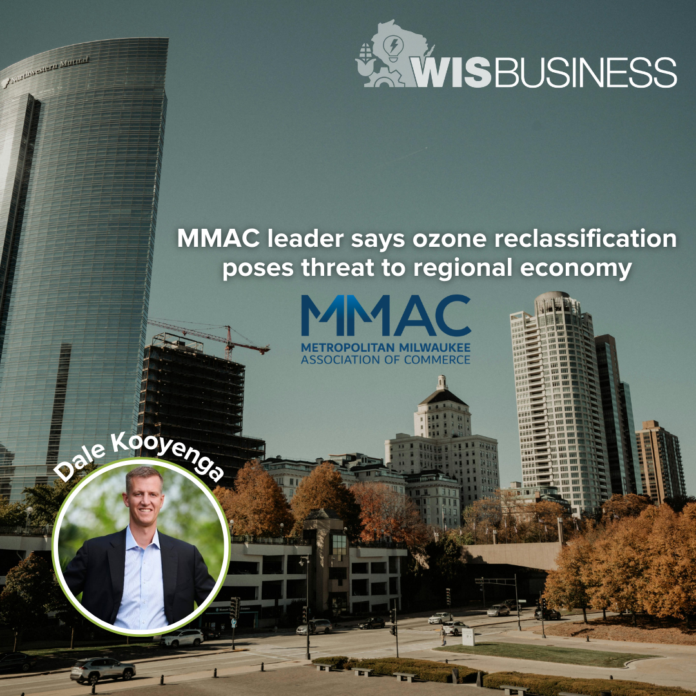The head of the MMAC says a recent air quality classification change for southeastern Wisconsin is likely the “most significant threat” to the regional economy, and could drive away companies looking to set up shop in the area.
Speaking Friday during an online briefing, Metropolitan Milwaukee Association of Commerce President Dale Kooyenga said the group is already seeing the consequences of the EPA’s classification change.
The agency in January changed a regional ozone nonattainment classification from “moderate” to “serious,” creating new emissions requirements for industry in the region. But the MMAC, chambers of commerce and economic development groups in the state are fighting the change, arguing the vast majority of the emissions that led to the change are coming from outside of Wisconsin.
“We have already had a large deal, with over 400 employees and hundreds of millions of dollars in investment, pull out of our region because of this,” Kooyenga said. “So on the economic development side, we’re already seeing negative consequences of this.”
The MMAC in January announced a coalition to counter the EPA’s classification change. The group is spearheading a national lobbying effort to amend the Clean Air Act of 1963, tapping Michael Best Strategies for the endeavor.
MMAC leadership has been meeting with the state’s congressional delegation to discuss the issue, and Kooyenga said both U.S. Sens. Tammy Baldwin, D-Madison, and Ron Johnson, R-Oshkosh, “in particular have been very helpful.” He added U.S. Rep. Bryan Steil’s 1st Congressional District is “arguably most proportionately impacted” by the change; he said the Republican lawmaker from Janesville will likely take a leading role in addressing it.
For member businesses in the region, Kooyenga said “the cost and uncertainty” associated with the new classification is a major concern. The “serious” ozone classification for the area carries increased regulatory burdens, according to Michael Best Partner Todd Palmer, affecting up to 450 industrial emissions sources.
Palmer described the new requirements as “Draconian,” noting companies that want to move to or expand in the region will need to deploy advanced emissions controls “without any consideration of cost,” among other restrictions.
Under an earlier, lower EPA classification, many industrial sources in the region were permitted at 99 tons of certain emissions or less, as the major source threshold under the federal program was 100 tons. But the latest classification shift moved that threshold down to 50 tons, according to Palmer.
“When that happened, all of those sources that received permits at 99 tons instantly became major sources under the federal Clean Air Act, yet they did not have permits that limited them to emissions less than that new 50-ton threshold,” he said. “They were essentially caught in this regulatory snafu, where they hold permits that they think keep them out of the federal program, but in fact no longer do.”
Palmer expects most affected companies “have no idea” that this has happened to them. For those that need new permits, some may take only a few weeks, but others could take up to 18 months, he said.
“All that time, they’re out of compliance. The maximum penalty for violating the Clean Air Act is over $100,000 per day,” he said. “They don’t seek that amount of penalty when they sue these companies, if they were to sue them, but that’s the maximum exposure they have.”
The framework for the higher classification comes from the Clean Air Act’s National Ambient Air Quality Standards, which define the maximum acceptable level of pollution in the air, Palmer explained Friday. But he said controlling emissions within metropolitan Milwaukee “has little, if any” effect on the ozone levels for the region, adding “it really is all attributable to transport.”
Palmer said Lake Michigan acts as an “ozone cooker” for the upper Midwest, as environmental factors drive pollutants from Chicago, Indiana and elsewhere upward over the lake, where they mix to form “extremely high levels” of the pollutant. That ozone then is blown onshore by lake breezes and picked up by monitors along the shoreline.
Kooyenga says the MMAC takes the environment very seriously, but doesn’t see this classification issue as environmental in nature.
“Essentially this is just a nonsensical consequence of a law that was written decades ago, that has a negative impact on our area, but is not a problem we have caused,” he said.
Just 10% of the ozone hitting Wisconsin’s shoreline monitors come from sources within the state, Palmer said, pointing to an analysis that “very clearly” shows most of it coming from Illinois and Indiana. Of that 10% coming from within the state, about 14% is from industrial sources.
“So the bulk of these regulatory problems that we’re talking about fall on the backs of industrial sources, however, at this point in 2025, those sources really are contributing very little,” Palmer said.
The regulatory challenge for businesses could get much worse in several years if nothing changes, he noted, referencing DNR projections showing the region will be bumped up to the “severe” category under the current trajectory.
“That will just increase the burdens on southeast Wisconsin even more,” he said.






